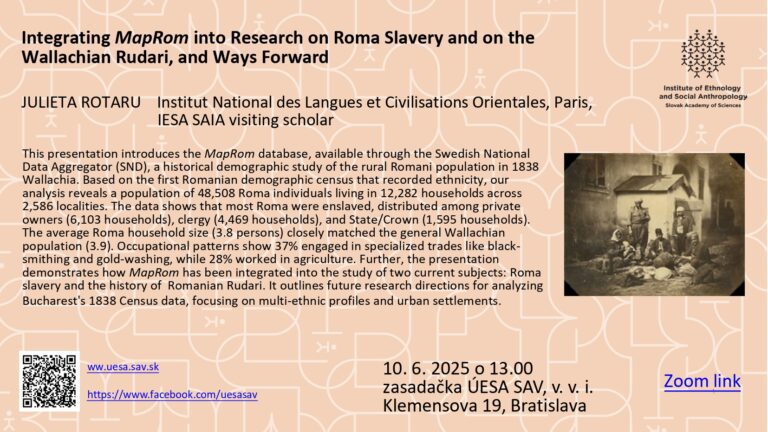Integrating MapRom into Research on Roma Slavery and on the Wallachian Rudari, and Ways Forward
- 10.6.2025
- о 13:00

V mene Vedeckej rady Ústavu etnológie a sociálnej antropológie SAV, v.v.i. Vás pozývame na odborný seminár, kde vystúpi visiting scholar Julieta Rotaru (Institut National des Langues et Civilisations Orientales, Paríž) na tému Integrating MapRom into Research on Roma Slavery and on the Wallachian Rudari, and Ways Forward. Odborný seminár bude konať v utorok 10. júna 2025 o 13.00 hod v zasadačke ÚESA SAV, v. v. i. na Klemensovej 19 v Bratislave.
Na podujatie sa bude možné pripojiť aj online prostredníctvom odkazu:
https://us06web.zoom.us/j/81703754312?pwd=dvquaORBzKsk7CBE6VTPT2ATa7PIdR.1
Meeting ID: 817 0375 4312
Passcode: 414426
Anotácia prednášky
This presentation introduces the MapRom database, available through the Swedish National Data Aggregator (SND), a historical demographic study of the rural Romani population in 1838 Wallachia. Based on the first Romanian demographic census that recorded ethnicity, our analysis reveals a population of 48,508 Roma individuals living in 12,282 households across 2,586 localities. The data shows that most Roma were enslaved, distributed among private owners (6,103 households), clergy (4,469 households), and State/Crown (1,595 households). The average Roma household size (3.8 persons) closely matched the general Wallachian population (3.9). Occupational patterns show 37% engaged in specialized trades like blacksmithing and gold-washing, while 28% worked in agriculture. Further, the presentation demonstrates how MapRom has been integrated into the study of two current subjects: Roma slavery and the history of Romanian Rudari. It outlines future research directions for analyzing Bucharest’s 1838 Census data, focusing on multi-ethnic profiles and urban settlements.